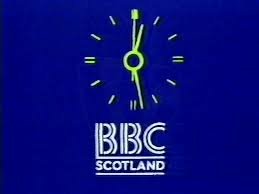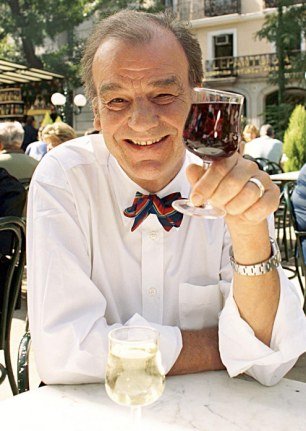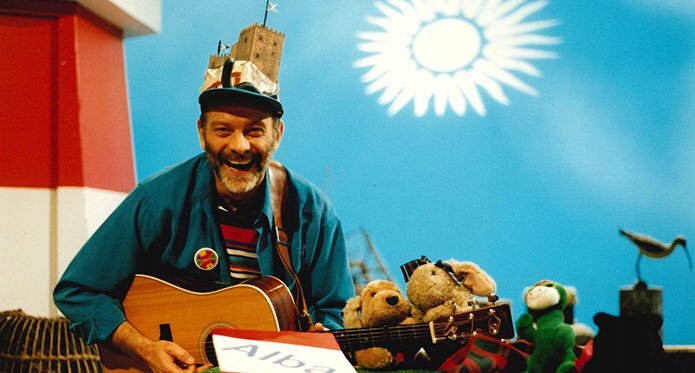Memories of Scottish Television
Growing up in Scotland in the 1980s and 90s, I don't remember there being a great deal of Scottish programmes on the television.
Unless your family had Cable TV or, in the early 90s, satellite telly, you had to make do with whatever the BBC, ITV and Channel 4 (Although the latter only launched in 1982) scheduled.
You can go on the BBC website and review the daily programme listings all the way back to 1964. So, not relying on my memory to support the above statement, I picked BBC 1 on the 28th of October 1986.
There’s a 5-minute regional news summary before the BBC’s national one o’clock news programme, a 25-minute regional news programme at 6:35pm and another summary during the Nine O’Clock News.
BBC Scotland’s closedown ident. 1980s
Everything else came from BBC London apart from the Chucklehounds, a kids show where two actors dressed as massive dogs got into a series of predictable misadventures. It went out on in the late afternoon on Children's BBC and was produced by BBC Manchester.
The Chucklehounds. Don’t be mean about it.
BBC 1 is the BBC’s premier channel, so maybe the lack of regional programming should be expected. With that in mind, I thought I’d take a look at BBC 2 Scotland’s schedule for the same day.
There’s nothing apart from a 5-minute regional news summary at 3:55pm. What there is, is perhaps the dullest programme schedule ever broadcast. See below and try to stay awake:
09:00 Gharbar A debate programme for the Asian community.
09:25 Ceefax Basically, a soul crushing space filler.
09:35 Daytime on 2 Programmes for Schools mainly.
14:15 Small World A programme on miniature furniture for doll houses.
14:25 Songs of Praise Pious people singing hymns. Repeated from Sunday.
15:00 Extraordinary Joe A show about a climber called Joe Brown.
15:55 Regional News They squeeze a weather update in too
16:00 Favourite Things Roy Plomley speaks to Phil Drabble. Fuck knows.
16:30 Treasure Houses of Britain “Palaces of Reason and Delight”. Fuck knows.
17:30 Schools Prom Features the Bournemouth School for Girls Flute Trio.
18:00 No Limits “Hear powerplay sounds!” Music show.
18:50 Personal View Victoria Wood talks about herself.
19:15 Under Sail For people who like sailing
19:35 Issues of Law For people who like the Law
20:00 Floyd on Food Functioning alcoholic cooks and gets pissed.
20:30 Top Gear Pre Clarkson. Dull hosts review a Talbot Horizon.
21:00 The Europeans Merchant Ivory pish starring Lee Remick off The Omen
22:30 Newsnight Pre Paxman politician baiting.
23:15 Weatherview Hopefully self explanatory.
It’s easy for me to glib and mean about the above schedule, but we had to take it or leave it. There were only four channels to choose from and perhaps the collective expectations were lower. BBC 2’s schedule appears to be exclusively aimed at the British middle-classes. The only highlight was watching Keith Floyd preparing elaborate dishes and getting smashed on expensive French wines for half an hour.
The late Keith Floyd. Loved a bevvie. Scottish ancestry?
BBC 1 and BBC 2 Scotland launched in the late 1960s in Central Scotland, in response to the growing number of regional ITV franchises in operation around the UK.
Regional stations could carry a lot more local programmes, many of which would eventually become syndicated on ITV franchises all over the country. Perhaps most successful and enduring example of this is long-running soap opera Coronation Street, which was created by the ITV franchise for the North-West of England, Granada. Less than a year after the first episode was broadcast, it was syndicated across the entire ITV network.
The ITV franchise in Scotland was owned by Scottish Television, or STV. as its commonly referred to. The station began broadcasting on the 31st of August 1957 with the first programme going out at 17:30. It was a variety show called This is Scotland and was broadcast from studios built in Glasgow’s Theatre Royal.
STV was the first ITV franchise to broadcast 7 days a week and soon become popular for musical entertainment, documentaries and sports coverage. Fanfare was the stations first sports related show. It was a quiz hosted by Archie McCulloch in which supporters of rival football teams competed against each other.
Perhaps the most popular programme of STV’s early years was the One O’Clock Gang, a comedy sketch and song show which went out every weekday at 1pm, obviously. Starring Dorothy Paul, Larry Marshall, Charlie Sim and celebrity chef Nick Nairn’s Dad, Jimmy. The show was huge and attracted a large studio audience too. In the 1960s, the weird kids who didn’t have lunch at school, would rush home to watch it.
Being a daily show, the writing was inconsistent, the stars often under rehearsed and the overall result was an uneven one. This didn’t put off the fans though and it ran for 10 years. It might still be running now if not for the late Charles Hill, chairman of the Independent Television Authority and general killjoy, hadn’t axed the One O’Clock Gang after a visit to Glasgow. He’s said to have been appalled by the show, remarking to station bosses; “I can’t believe you’ve been getting away with this!”
I’m sure there are still men in Glasgow who use the image of a young Dorothy Paul, dressed as a schoolgirl for the Friday edition, to keep them warm on a lonely evening.
The One O’Clock Show gang, including Scotland’s original sex symbol, Dorothy Paul.
My personal memories of STV’s output in the 1980s are dominated by two programmes; Scotsport and Glen Michael’s Cartoon Cavalcade.
Scotsport first aired a month after STV began broadcasting. It was originally called Sports Desk and was presented by the redoubtable Arthur Monfort for 32 years. Monfort retired in 1989 and I remember him well. My Saturday late afternoons in the early and mid 80s were spent lying on the floor of my grandparent’s house in Kilsyth, surrounded by Star Wars figures and helping my grandfather check his Pools coupon. He would flip between the incoming football results on BBC 1 and the highlights of the day’s action on Scotsport.
Ever the eternal optimist, or maybe as a means of enlisting the willing assistance of his young grandson, he was always sure his coupon would come in that week. He would scrutinise it while Monfort analysed the day’s SFA action with a guest, before tearing it up and cheerfully remarking; “Ah well, another week of work” or words to that effect.
The original host of Scotsport in the seat he’d occupy for 32 years, Arthur Monfort.
Glen Michael’s Cartoon Cavalcade was on, on Sunday afternoons. It might be difficult for younger readers to understand why kids of my generation would get so excited about a middle-aged man and a talking paraffin lamp presenting American cartoons. But you need to understand how monumentally boring Sundays were in the 1980s. All the shops were closed, most of the morning telly programmes were religious or political shows and none of our mates seemed to be about. No doubt having been dragged off to visit grandparents, aunties, uncles etc.
There might be a film on in the afternoon, but it was more likely to be a classic from the 40s or 50s and unlikely to hold the attention of a restless 8-year-old with a crap haircut. Having said that, I recall seeing The Towering Inferno on one such Sunday afternoon at a fairly impressionable age, and being absolutely traumatised.
Inappropriately scheduled disaster films aside, good old Glen was a shimmering 30-minute oasis in a desert devoid of fun and entertainment.
The show first aired in way back in 1966. Glen would present fun links between Warner Brothers and Hanna-Barbera cartoons. Occasionally he’d show the old Spider-Man cartoon with the catchy theme tune and the animated adventures of the Fanatastic Four.
Over the years he was joined by Paladin, the aforementioned talking lamp, Totty the robot and dogs; Rudi and Rusty. They would read out birthday cards, perform skits and sketches and often film on location, visiting places like Edinburgh Zoo and the Botanic Gardens in Glasgow.
The popularity of Cartoon Cavalcade in its heyday can’t be understated. Glen would receive over 2000 letters and cards from children every week to read out on air and be mobbed when he ventured out in Glasgow. Glen was a kid's TV superstar and one of a small group of presenters from this time we can still talk about. We didn’t even mind the fact Glen was English! Scottish comic book writer Mark Millar has such fond memories of Glen, he got him a cameo in the movie version of his Kick-Ass comic series.
Cartoon Cavalcade was finally axed in 1992 and replaced by Wemyss Bay 902101 and Skoosh. Neither were very good.
I’m pleased to report that Glen is still with us. At the superb age of 96, he’s very much retired, but still gives the odd interview to nostalgic reporters of the Scottish Press.
The wonderful Glen Michael with Paladin the talking lamp.
Undoubtedly the most famous Scottish shows of the 1980s are Taggart and Take the High Road. I won’t write too much about them here, as both deserve dedicated blog posts, but they’re arguably Scotland’s most famous televisual exports and still known the world over, even now. Stay posted for future articles about both shows.
No article about Scottish television in the 80s and 90s would be complete without mentioning the phenomena that was Dotaman. Presented by Donnie Macleod, formally of the group Na h-Oganaich, Dotaman was a kids show in a similar vein as Play-School and Sesame Street, presented entirely in Gaelic. Dotaman is Gaelic for Spinning Top. On each episode Donnie would sign songs relevant to young pre-school kids, usually wearing a funny hat related to the content of the song. It’s thought that many young Gaelic speakers learned their early vocabulary from the programme and today, Donnie has become somewhat of a cult figure.
However, for an 8-year-old non-Gaelic speaker from Glasgow, it was always disappointing to find that it was usually a choice between Dotaman or Pebble Mill on a rainy summers' morning.
Presenter of Gaelic kids show Dotaman, Donnie Macleod.
In 2022, the days of iPlayers, YouTube and digital television mean we can find classic Scottish television shows from this era online. YouTube in particular, is great for finding clips and often full episodes of classic Scottish programmes. BBC Scotland has its own digital channel and there’s even BBC Alba, a channel completely devoted to Gaelic speaking Scots. Both channels do seem to show a lot of curling, but you can often find fantastic documentaries on both about the history of Scottish sport.
But for those of us of a certain age, the whole family gathering around the TV to watch the likes of Scotsport, Glen Michael or Taggart will always be a potent memory. Whenever I come across clips of classic Scottish shows, commercials or continuity announcements while researching for the podcast, I’m immediately transported back to the living-rooms of my childhood. Gas fires, scratchy carpets, glasses of room temp Irn Bru (How it was intended to be consumed), toasted cheese and horrible clothes chosen by my mother.
What a time to be alive.







